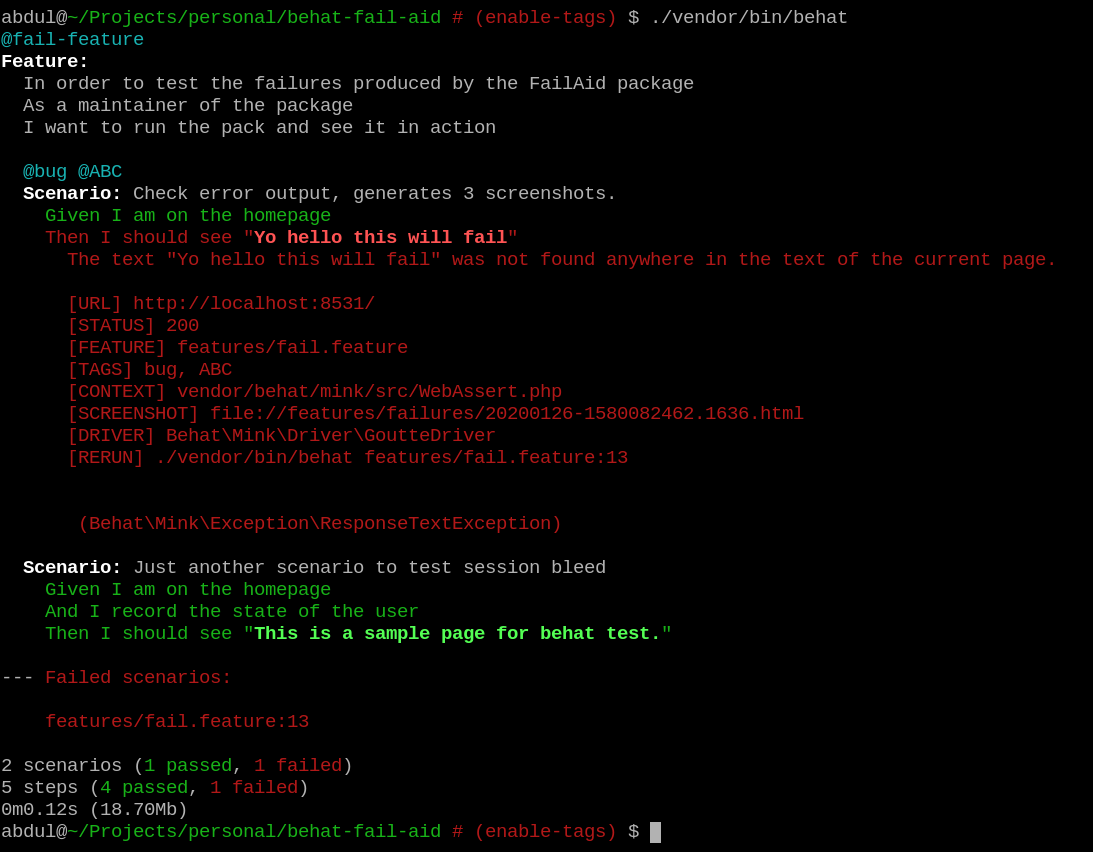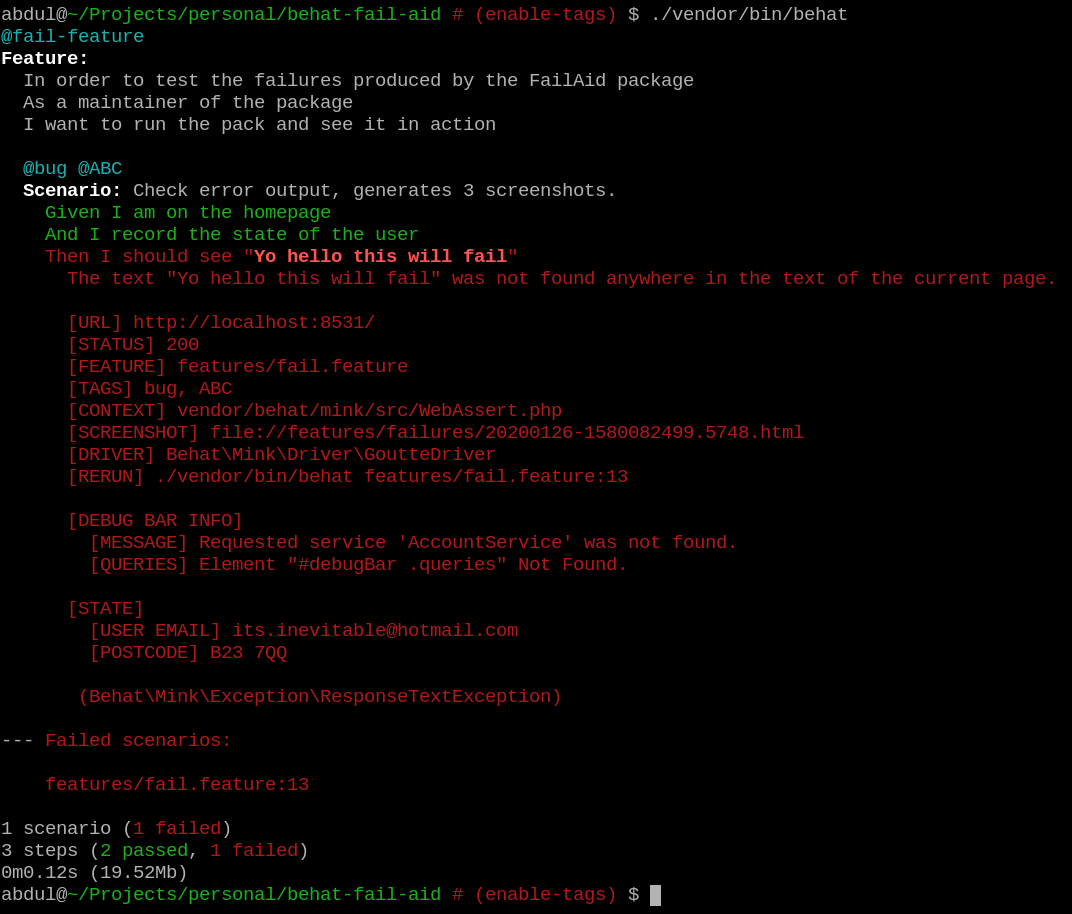genesis / behat-fail-aid
Get more out of your test suite by getting it to work with you when tests fail. Screenshots and more. Works with Goutte and MinkExtension.
Installs: 1 238 028
Dependents: 23
Suggesters: 8
Security: 0
Stars: 28
Watchers: 2
Forks: 6
Open Issues: 16
Requires
- behat/mink: *@stable
- behat/mink-extension: ~2.0
- behat/mink-selenium2-driver: ~1.3
Requires (Dev)
- behat/behat: ^3.5
- behat/mink-goutte-driver: ^1.2
- ciaranmcnulty/behat-localwebserverextension: ^1.1
- phpunit/phpunit: ~4.0
Suggests
- genesis/db-backup-restore: Quickly backup and restore your database.
- genesis/sql-data-mods: Extends behat-sql-extension to provide a powerful and simple framework to manage your data modules.
- genesis/test-routing: Simplistic routing that can extend main app routing for testing purposes.
- dev-master
- 3.7.5
- 3.7.4
- 3.7.3
- 3.7.2
- 3.7.1
- 3.7.0
- 3.6.1
- 3.6.0
- 3.5.1
- 3.4.0
- 3.3.0
- 3.2.0
- 3.1.0
- 3.0.2
- 3.0.1
- 3.0.0
- 2.5.3
- 2.5.2
- 2.5.1
- 2.5.0
- 2.4.2
- 2.4.1
- 2.4.0
- 2.3.6
- 2.3.5
- 2.3.4
- 2.3.3
- 2.3.2
- 2.3.1
- 2.3.0
- 2.2.1
- 2.2.0
- 2.1.3
- 2.1.2
- 2.1.1
- 2.1.0
- 2.0.2
- 2.0.1
- 2.0.0
- 1.3.0
- 1.2.1
- 1.2.0
- 1.1.0
- 1.0.2
- 1.0.1
- 1.0.0
- dev-dependabot/composer/guzzlehttp/psr7-1.9.1
- dev-sample
- dev-output-params-control-executed-code
- dev-wait-on-failure
- dev-autoclean-run-once-per-entire-test-execution-rerun-line-number
- dev-js-log-code-does-not-break-non-js-drivers
- dev-feature/detect-when-the-page-is-blank
This package is not auto-updated.
Last update: 2025-01-09 18:26:36 UTC
README
Introduction
Time and time again we've all seen how difficult and stressful it can become to fix behat tests. This package is their to help gather all possible information around failures and print them as you see a failure taking out the need to do basic investigations with minimal setup.
The links are ready to be clicked on and opened in the browser. No faff!
You also get the following step definitions for free upon activation:
And I take a screenshot And I gather facts for the current state
These will output relevant information on the screen. (Your formatting must be pretty for this to work --format=pretty).
Whats new:
Major: Refactor, Controlled output, scenario debug cli, clear screenshots cli, host machine screenshot url.
Minor:
- Resolve environment variables for hostUrl and hostDirectory options.
- Execute screenshot code only if requested in output.
- Override output parameters through individual context file params.
- Override more output parameters.
- Set output.api parameter to true to set all mink related flags/operations to false for quick settings.
Patch: NA.
Installation:
composer require genesis/behat-fail-aid --dev
CLI
Clear screenshots:
The --clear-screenshots flag, if supplied will remove existing screenshots from the directory specified.
Scenario debug:
The --scenario-debug flag, if supplied will take attempt to screenshots after each step and display in the console to aid debugging. Best used when working on a single scenario along with the autoclean feature.
Wait on failure:
the --wait-on-failure={seconds} option can be used to investigate/inspect failures in the browser.
Feedback on failure:
the --feedback-on-failure flag can be used to print failures as soon as they occur. This is useful when using the progress formatter for example in long running test packs such as CI.
Config/Usage:
#behat.yml default: suites: default: contexts: - FailAid\Context\FailureContext extensions: FailAid\Extension: ~
This is the basic setup and will give you a lot of information on failures. For more options read through the rest of the README. Any of the options below can be used in conjunction with each other.
Output options:
You can control the verbosity of the aid text from the config file. By default, all options are enabled.
default: extensions: FailAid\Extension: output: api: false # (Set this to true if testing against API's which don't use mink). url: false status: false tags: false feature: false context: false screenshot: false driver: false rerun: false debugBarSelectors: false
These params can be overridden for each FailureContext declaration in behat.yml
#behat.yml default: suites: web: contexts: - FailAid\Context\FailureContext API: contexts: - FailAid\Context\FailureContext: - output: screenshot: false extensions: FailAid\Extension: output: screenshot: true
screenshot options:
#behat.yml
...
FailAid\Extension:
screenshot:
directory: /temp/failures/behat/screenshots/
mode: default
autoClean: false
size: 1444x1280
hostDirectory: /tmp/$USER/failures/
hostUrl: http://ci/failures/$BRANCH_NAME/$JOB_NUMBER/failures/
directory (string):
Override default screenshot path. Default folder is provided by sys_get_temp_dir() function. Can be a relative path.
mode (string):
default: Drivers will produce a png where supported, html otherwise.
html: All drivers will produce html screenshots, useful for interrogating runtime code.
png: All drivers will produce png screenshots, or die trying.
autoClean (bool):
Clean up the directory before the test suite runs.
Size (string):
The size of the screenshot to be taken on failure. At present, does not reset the size of the window. May conflict with the maximiseWindow API.
hostDirectory (string):
If running against a VM or container, you can set this path to the screenshots directory on the host machine. The screenshots will be produced the same, the output will be for your host machine instead. Resolves environment variables.
HostUrl (string):
If running on a remote environment it may be that the failures are available on a url. Resolves environment variables.
siteFilters option:
#behat.yml ... FailAid\Extension: siteFilters: '/images/': 'http://dev.environment/images/' '/js/': 'http://dev.environment/js/'
Applied on the content of a html screenshot. Useful when working with relative urls for assets.
Tracking js errors/logs:
You can easily track JavaScript activity on the page whenever a fail occurs. Place the following snippet in the head section of your application (make sure its global):
<script type="text/javascript"> window.jsErrors = []; window.jsWarns = []; window.jsLogs = []; window.onerror = function(error, url, line) { window.jsErrors.push('[Uncaught error]: ' + error + '; Line: ' + line); }; if (!console) var console = {}; var _privateError = console.error; console.error = function() { window.jsErrors.push('[Console error]: ' + JSON.stringify(arguments)); _privateError.apply(console, arguments); } var _privateWarn = console.warn; console.warn = function() { window.jsWarns.push('[Console warn]: ' + JSON.stringify(arguments)); _privateWarn.apply(console, arguments); } var _privateLog = console.log; console.log = function() { window.jsLogs.push('[Console log]: ' + JSON.stringify(arguments)); _privateLog.apply(console, arguments); } </script>
Your original debugging messages will still appear in your console.
#behat.yml ... FailAid\Extension: defaultSession: chrome # If you've got multiple sessions registered. If its a standard setup you won't need this. trackJs: errors: true warns: true logs: true trim: 1000
When errors is enabled, any intended console.error calls and js exceptions will be recorded and displayed as part of the failure. Trim is applied on messages to shorten to the specified length.
debugBarSelectors option:
#behat.yml ... FailAid\Extension: debugBarSelectors: #Only CSS selectors allowed. 'Status Code': '#debugBar .statusCode' 'Error Message': '#debugBar .errorMessage' 'Queries Executed': '#debugBar .executedQueries' xhrRequests: callback: MyXhrRequestsInfoExtractor::extract
The above will go through each of the selector and find the element. If the element is found, it will display the text contained in the failure output. The debug bar details are gather after taking a screenshot of the page, so its safe to navigate out to another page if needs be. If you have to do this, have a look at the 'Advanced Integration' section for more information.
defaultSession option:
When you're using multiple sessions you can configure to use a particular session only with the fail aid extension.
...
FailAid\Extension:
defaultSession: mySession
...
Recording states:
You can record the state of your test for a failure. A state resets before each scenario.
# FeatureContext.php <?php use FailAid\Context\FailureContext; class FeatureContext { /** * @Given I am logged in */ public function login() { $email = $this->createUserWithRandomEmail(); // assume this returns abc@xyz.com $this->fillField('email', $email); $this->fillField('password', 'xxxxxxxx'); $this->press('login'); FailureContext::addState('test user', $email); } }
When the above step definition is used in any scenario, it will record the test user email within the current state of the scenario. If the scenario fails, you will get any information stored in the state within the failure message.
...
[STATE]
[TEST USER] abc@xyz.com
...
Common debugging issues:
Its very common for a debug bar to interfere with your tests i.e 'your click will be received by another element' when performing JS enabled behaviour tests. In those cases, I would advise not to turn the debug bar off, but to execute code to hide it instead. In terms of debugging, gathering as much information as possible is paramount to a speedy fix. I would suggest placing your hideDebugBar() code after a visit call. This could be as simple as clicking a hide button on the bar.
Advanced integration:
Sometimes your logic will be more complicated and passing in options may not work for you. In those cases, it is advisable to have a look at the FailureContext of what it allows you to override. You can extend the FailureContext with your own context class, and override parts that you deem necessary. You will have to register your own class with the behat.yml contexts section.
To register with all suites without separate configuration, or just doing it in code:
# FeatureContext.php <?php use Behat\Testwork\Hook\Scope\BeforeSuiteScope; use FailAid\Context\FailureContext; class FeatureContext { /** * @BeforeSuite */ public static function loadFailureContext(BeforeSuiteScope $scope) { $params = [ 'screenshot' => [ 'directory' => null, 'mode' => FailureContext::SCREENSHOT_MODE_DEFAULT, 'autoClean' => false, ], 'siteFilters' => [], 'debugBarSelectors' => [], 'defaultSession' => 'mySession', ]; $scope->getEnvironment()->registerContextClass( FailureContext::class, $params ); } }



